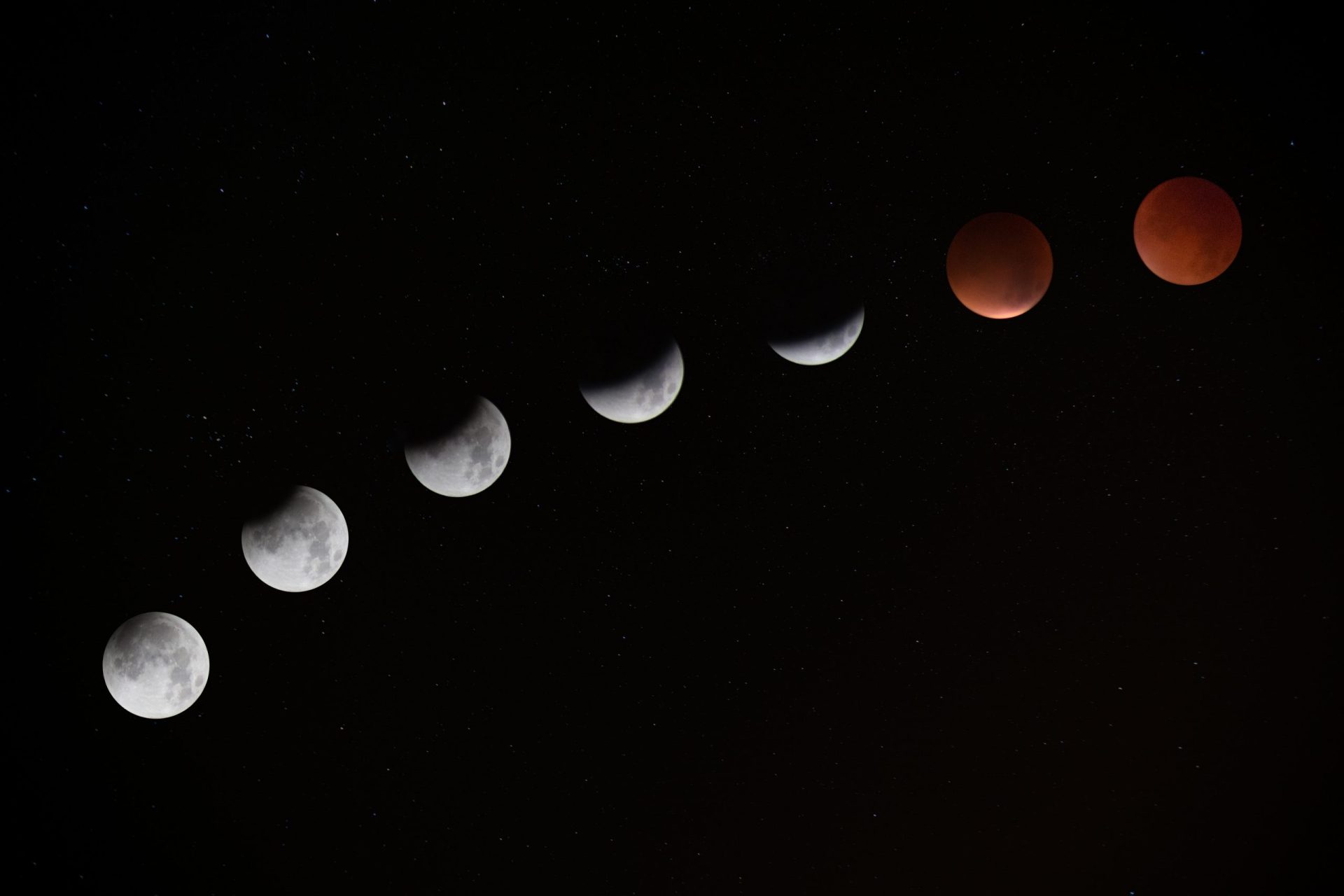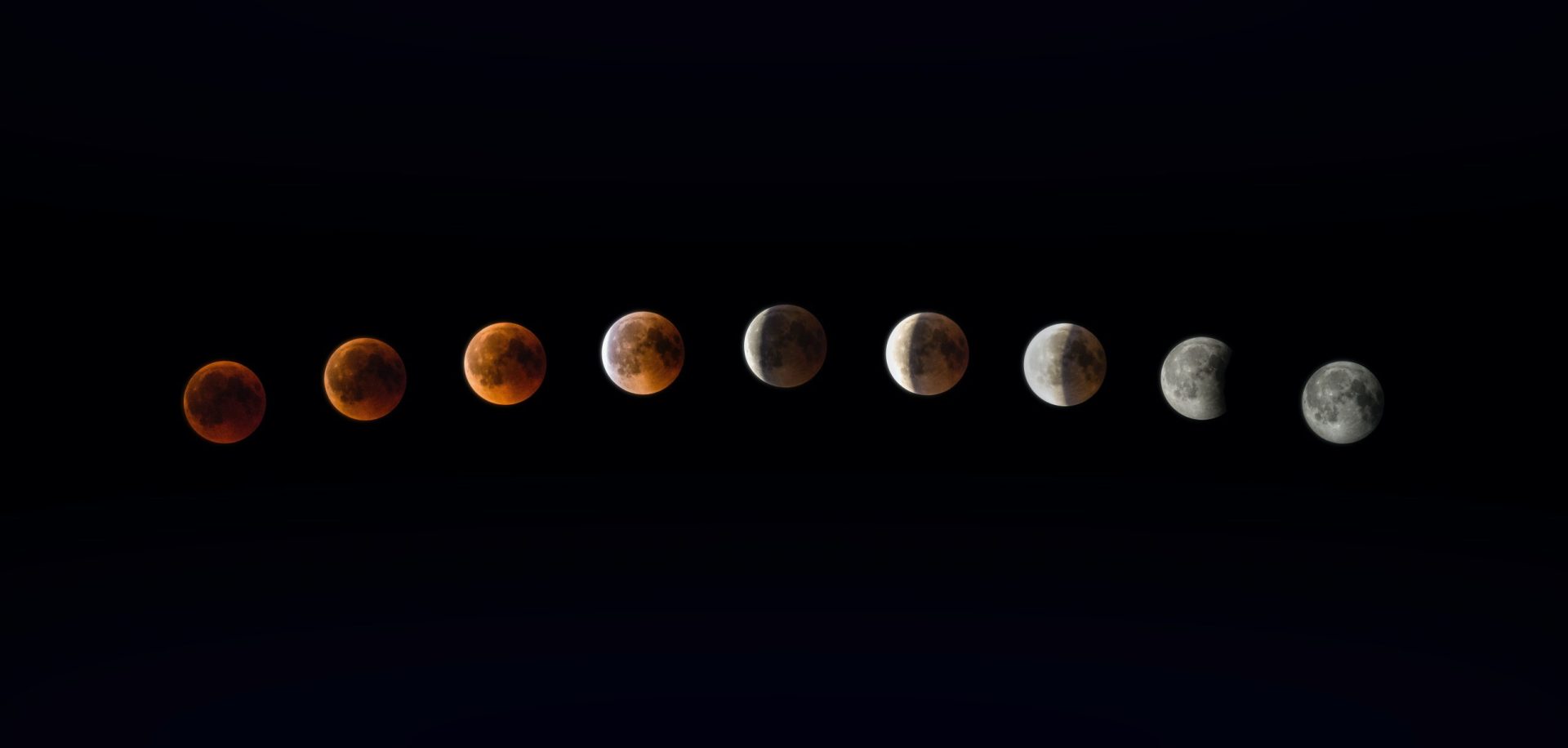Total Lunar Eclipse
The upcoming total lunar eclipse on 15 – 16 May of the Flower Moon (starting at 7:27pm on 15th May on the West coast of United States) will be visible in the entire Americas, Africa, and Western Europe.
Kindly read this article and find out if you are affected, and thereafter click the link at the end of this article to take a short quiz about lunar and solar eclipses and learn more about these phenomena.
An eclipse event never occurs alone; at least one solar eclipse always occurs about two weeks before or after a lunar eclipse, though it might not be visible in the same regions of the world. Sometimes, there are three eclipse events during the same eclipse season.
Anywhere between zero and three lunar eclipses can occur in a calendar year. We know that the shadow of the Earth falling on the Moon brings about a lunar eclipse. This can happen only on a full moon when Moon and Sun are posited opposite in mutual aspect, while the Earth moves in between them and reduces the Moon’s light source.
In simple terms, the Earth’s shadow that falls on the Moon during a lunar eclipse is either penumbral or umbral. The penumbra is the lighter outer part of Earth’s shadow where only partial sunlight is obscured. The umbra is the dark, central part of Earth’s shadow where all sunlight is blocked—this is the phenomenon that creates ‘nighttime’.
When the Moon is fully encapsulated by the umbral shadow, we observe a total lunar eclipse from the Earth. If the Moon passes partially through the umbral shadow, then a partial lunar eclipse is observed from the Earth. An exclusive penumbral eclipse occurs when the Moon passes only through the penumbral portion of the shadow without touching the umbra.
As the Moon enters Earth’s umbral shadow, it will turn a rusty color as it reflects sunlight being refracted through the Earth’s atmosphere. In other words, the lunar eclipse is illuminated by all of Earth’s sunrises and sunsets reaching the moon, hence why a total lunar eclipse is often called a blood moon.

Coordinates of Upcoming Lunar Eclipse
More details about the red hue can be found at:
https://www.timeanddate.com/eclipse/why-does-moon-look-red-lunar-eclipse.html
The exact time-period of this eclipse will depend upon the latitude and longitude of your location.
Here is an interactive map (scroll down the page to animate the eclipse map) detailing where this eclipse is visible:
https://www.timeanddate.com/eclipse/lunar/2022-may-16
A lunar eclipse has nearly equal probability of being a total, partial umbral or only penumbral. Those of you studying or following the Saros cycle on periodicity of eclipses, please refer to this link for details:
https://eclipse.gsfc.nasa.gov/LEsaros/LEsaros134.html
As per the ancient Sanskrit soli-lunar calendar, the umbral eclipse time-period determines the actual impact of a lunar eclipse. For example, in Los Angeles, California the moon enters the umbra on Sunday, 15th May from 7:27pm, however it will be appear above the horizon only from 7:40pm; the total eclipse starts from 8:29pm with the maximum eclipse at 9:11pm; the total eclipse ends at 9:53pm, and the moon leaves the umbra at 10:55pm, as shown in this location guide:
https://www.timeanddate.com/eclipse/in/usa/los-angeles
You may determine the nature, extent, and time duration of the eclipse relevant to your location using the above link and creating your own location eclipse guide.
How to Face an Eclipse
In general, eclipses indicate an interruption of the energy of the luminaries and hence are deemed as important events for life on Earth. An eclipse affects all plants and trees especially those on land receiving the sunlight and moonlight directly. Other living creatures such as birds, mammals, reptiles, amphibians and even insects have been seen harnessing the power of these transitional events.
While animals seem to be attuned to the forces of nature and better informed, the effect of an eclipse on humans tends to manifest in different ways and to varying degrees. These effects can be analyzed based on the particular position or placement of luminaries at the time of one’s birth. This is calculated accurately by Sanskrit-based Jyotiṣa-vidyā, which astronomically maps the coordinates of the celestial bodies, including distant star clusters and asterisms, at the time of birth using a dynamic soli-lunar calendar.
This indigenous knowledge base (gaṇīta-śāstra or Vedic mathematics) is a Vedic Sanskrit heritage that is still practiced in India, and while the tradition retains its authentic depth, it is much less prevalent than before. If and how an eclipse affects an individual is a specific and detailed calculation and is in itself a vast subject. As such effects on an individual level are mostly out of our control, they are best mitigated at a personal level by way of contemplation or meditation.
Based on Jyotiṣa-vidyā, the effects of an eclipse can last for three to six months if of particular significance to an individual, whereas the effects can last for up to a year if relevant to a country. An eclipse of great magnitude influences life across the entire globe to varying degrees. It impacts in such a way that the effects do not necessarily manifest quickly, but rather develop over the subsequent months. Typically, the solar eclipse impacts more than the lunar eclipse with the effect lasting longer.
This upcoming lunar eclipse takes place on the Naxatra (star cluster or asterism) of Viśākhā (also known in the Latin classification as the stars Alpha, Beta, Gamma and Iota Librae) but affects the two other lunar asterisms in its triad. Thus, this lunar eclipse will affect the mind of anyone born with the Naxatra of Viśākhā, Punarvasu (stars Castor and Pollux), and Purva-bhādra-pada (stars Alpha and Beta Pegasi); the latter two-star clusters are associated as part of the triad of star clusters affected. Likewise, every lunar eclipse will impact a triad of lunar star asterisms. This is why the birth star is deemed important from the perspective of an eclipse.
Mindfulness and remedial spiritual practices are the call of such times. There is however the geological momentum and forces of nature that are verily beyond our control, and all we can do is share positive energy, mindful service and be prepared as best as possible.

Meditation during an Eclipse
Whereas eclipses and their effects have been either closely followed or studied by many traditions and cultures, meditators patiently wait for such moments to come forth. This is because the depth and power of meditation increases manifold during a visible eclipse. An event like this brings an excellent opportunity for enhancing one’s spiritual practice.
Regular and persistent practice of meditation can be made to culminate in a new level or the attainment of a special result, a siddhi, from an eclipse. From this perspective, a total eclipse or an “almost” total eclipse is a greater opportunity to excel in meditation, while a partial eclipse is somewhat less of an opportunity but nevertheless still worthwhile. Seekers in countries where the eclipse is only partially visible can still embrace the meditation practices even though the gainful effects will be milder; however, if the eclipse is not visible at all, the meditation benefits do not multiply.
For a meditator to gain the maximum advantage, Sanskrit literature suggests fasting for 9 hours ahead of the start time for a lunar eclipse (and fasting 12 hours in the case of a solar eclipse). This is of course difficult to practise with the modern lifestyle, especially when working during the day. However, some of the other aspects of preparing for an eclipse could perhaps be done, such as fasting during the entire eclipse period and even abstaining from drinking water during the eclipse. One can drink just enough water ahead of time so that the contemplative practices during the eclipse are not interrupted. Those not able to fast can have a light snack well ahead of the eclipse. Food and drinks are not taken during or at the beginning of the eclipse.
It is traditional among those who follow the eclipse routine to take a wash (a shower) right before the onset of the umbral eclipse and then take another shower just after the end of the umbral eclipse. These washes or showers can be undertaken during the penumbral phase of the eclipse. The two showers or full body ablutions are associated with two changes of fresh clothes and is known as a samputi system of locking the energy of the eclipse through a customary cleansing. In case of a lunar eclipse, showers or ablutions can be taken during the beginning and ending penumbral periods sandwiching the umbral meditation session.

Taking rest after the second shower would be deemed normal. Fasting can be ended right after this shower and change of clothes. A well-structured pre-planned meditation is usually better practised indoors in a familiar surrounding remaining on one’s own seat of repose (āsanam) without the distraction of outside environment.
In the example for Los Angeles, California, the first shower or ablution can be taken after the onset of the penumbral eclipse after 6:32pm but before the 7:27pm umbral eclipse and thereafter the second shower or ablution may be taken right after 10:55pm at the end of the umbral eclipse but ideally before 11:50pm (end of penumbral eclipse).
In Los Angeles, the entire umbral eclipse time-period of 7:27pm until 10:55pm on 15th May can be used for the meditation practice. Furthermore, maximum intensity of meditation practice can be applied during the time period of total lunar eclipse from 8:29pm to 9:53pm, while planning for the highest intensity of practice overlapping with the maximum lunar eclipse at 9:11pm.
It would be wise to make sure that at least one complete meditation session is done. The peak eclipse is the most intense. Therefore, for those wishing to meditate during the eclipse or preparing to intensify their existing contemplation, may plan the practice to maximize the overlap with the period of the peak eclipse period.
One might need to extend the meditation time by repeating one’s usual meditation techniques several times. In that case, repeating a sequence an odd number of times (such as thrice) is better than an even number. However, the depth and quality are more important than number of repetitions.
This is a summary of relevant recommendations from the Sanskrit literature. It is best to utilize this rare opportunity to intensify personal contemplation or meditation practice.
We invite you to take this QUIZ to check your understanding about lunar and solar eclipses and learn additional information about these celestial phenomena.



